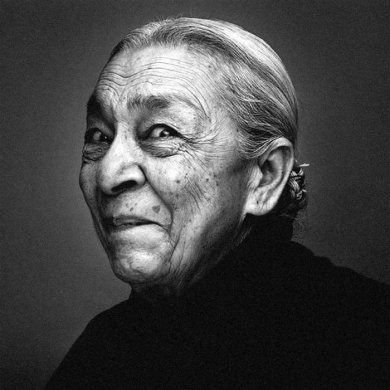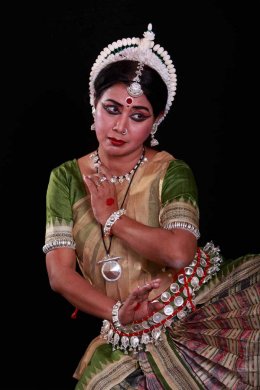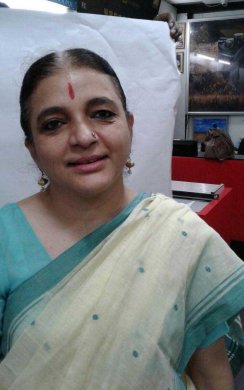
|   |

|   |
 e-mail: sunilkothari1933@gmail.com Zohra Segal Arts Festival Photos courtesy: Kiran Segal May 17, 2018 The concept of the existential philosophy, 'I am therefore you are,' took shape in form of Nayaka Pratinayaka by Aruna Mohanty in Odissi dance to the libretto written by Odiya poet/critic Kedar Mishra. When I first saw it in Bangalore, it made an impression on me. The memories were revived again when Aruna Mohanty presented it during Zohra Segal Arts Festival at IIC in New Delhi. 
Zohra Segal
Kedar Mishra took up archetypal characters from Satya Yuga, Treta Yuga, Dwapara Yuga and Kali Yuga. That offered Aruna enough scope to create the characters. The text was in Odiya and there were comments also in English for each Nayaka and Pratinayaka. Singing and music made it dramatic when both Nayaka and Pratinayaka asserted their beings: I am therefore you are. With red back light creating silhouette, a stool in front served as throne, place or palace as per the dictates of the story of each eon. In Satya Yuga, if there was demon Hiranyakashipu, so was there Narasimha, half lion and half man incarnation of Vishnu. The well known story of the demon king seeking immortality and his inability to tolerate his son Prahlada worshipping Hari, father challenging son to prove if his God Hari was omnipresent, and if so was he in the pillar? He strikes the pillar and out jumps the figure of Narasimha who kills Hiranyakashipu. The poet reiterates: I am therefore you are! The character of Pratinayaka was etched well with vigour and tandava element.  Aruna Mohanty Come Treta Yuga and the Nayaka and Pratinayaka are Lord Rama and Ravana. The Odiya poetry repeats 'I am therefore you are.' In suggestive abhinaya encompassing major episodes of Ramayana - Ravana in disguise as mendicant kidnaps Sita, Sita throws her ornaments, fight with Jatayu, monkeys building bridge Setu over ocean, Rama's crossing it and the duel between Ravana and Rama, Rama killing Ravana by shooting an arrow at the vessel of nectar in stomach of Ravana and his death - the existence of Nayaka and Pratinayaka was artistically established. Aruna's impersonation as Rama and Ravana was distinct. Dwapara Yuga had Kamsa as Pratinayaka and his nephew Krishna, the eighth child of his sister Devaki, as Nayaka. Krishna arrives and kills elephant, Kamsa is frightened remembering the prophecy that the eighth child of Devaki would kill him. Kamsa is unable to bear the attahasya laughter; he places his palms on his ears and is frightened knowing that Nayaka will annihilate him. The use of light to enhance the fear was dramatic. Emerging from behind the throne and out of fear running hither and thither, Kamsa's character came alive. The duel between Kamsa and Krishna echoed the statement: I am therefore you are. In Kali Yuga, Truth stood out as Nayaka. All the elements of greed, arrogance, ego, lust, violence stood out as Pratinayaka. Aruna depicted gambling and greed to amass wealth, stealing and arrogance in a versatile manner. In particular, the seduction was portrayed by women of easy virtue, with all the coquetry to the use of pallavi artistically with lusty rhythm. And the violence, killing innocent people, striking terror found reflection in Aruna's abhinaya, like navarasas were at her beck and call. Despite all these opponents, the final victory was of Truth. Pratinayaka and Nayaka existed – one is there, therefore the other is there. In Odiya, mu achhi boli tumi accho. Due to technical glitch, the English commentary was not clearly heard. However, for its innovative theme, the entire presentation engaged one's attention. Aruna has consistently explored various themes and concepts successfully in Odissi. Quite in contrast she presented an ashtapadi Madhave ma kuru manini maye from Gita Govinda, set to music by Subas Pani. The Sakhi admonishes Radha for her pride and not going unto Krishna, who is resting on a bed made of lotuses awaiting her. Sakhi makes her realize that he is divine. Aruna while dancing this aspect used subtly the various incarnations, which was an artistic ploy. Her choreography clearly depicted characters of Radha, Sakhi and Krishna. Finally Sakhi pushes her to go to meet Krishna. In the opening number of Varsha, various images of clouds gathering in sky compared to elephant, the lighting like flag, the sound of clouds like the sound of mardala (drum), the dancing peacock, the falling of raindrops, the flowering of grass shoots, and the Indrachap (rainbow) evoke in the nayika separated from the beloved, the desire for union with the nayaka, and when he arrives dancing merrily, she goes with him. The varying moods were choreographed highlighting the poetry. The musicians accompanying Aruna were Vijaykumar Barik on mardala, Ramesh Das on violin, Rupak Kumar Parida for vocal and Srinibas Satpathy on flute. Pt Ramhari Das had composed the music and rhythm was provided by Dhaneswar Swain. Traditional Pala music was used for Varsha.  Rimpa Siva  Nageen Tanveer
Earlier, a young percussionist Rimpa Siva mesmerized the audience with her excellent playing on tabla. A born tabla player trained by her father from childhood she had flair to conclude the bols and various styles of different tabla masters including her father. Endowed with energy, she was a complete delight. The three day festival also had screenings of a documentary Mazhahabi Laddoo, the film Chini Kam starring Zohra Segal, Amitabh Bachan and Tabu directed by R. Balki, Chhatisgarhi folk music by Nageen Tanveer and Charandas Chor play by Habib Tanvir's Naya Theatre. In the foyer were exhibition of Ohara School of Ikebana and Delhi Blue Pottery Trust. Dadi Padumjee's Ishara Puppet artists in their colourful costumes welcomed the audience. The festival was coordinated by Kiran Segal. It was dedicated to Joy Michael, the late director of Yatrik, a close associate of Zohra Segal.  Dr. Sunil Kothari is a dance historian, scholar, author and critic, Padma Shri awardee and fellow, Sangeet Natak Akademi. Dance Critics' Association, New York, has honoured him with Lifetime Achievement award. Post your comments Please provide your name and email id when you use the Anonymous profile in the blog to post a comment. All appropriate comments posted with name & email id in the blog will also be featured in the site. |